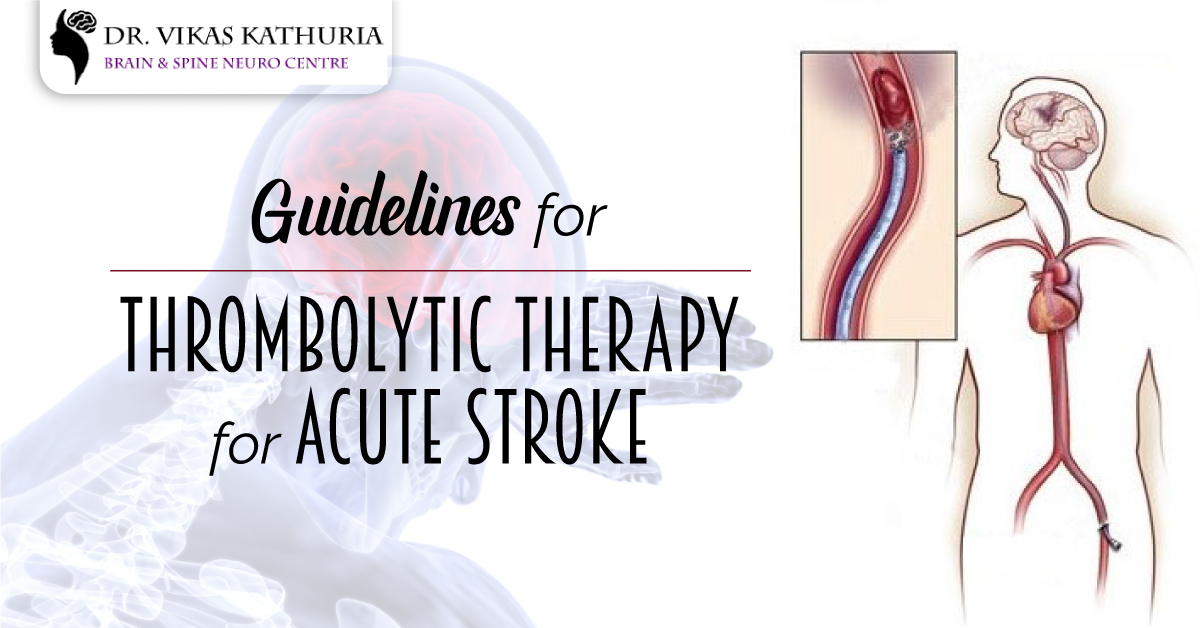Guidelines for Thrombolytic Therapy for Acute Stroke

Blood clots most often cause heart attacks and strokes. Deep vein thrombosis, or DVT, is when a blood clot in your leg breaks loose and travels to your lungs, resulting in a pulmonary embolism.
Thrombolysis aims to break up blood clots with drugs or a minimally invasive technique. Penn Medicine specialists thoroughly examine the origin of blood clots and then offer the best medication or treatment to correct clotting disorders.
Thrombolytic Therapy: What Is It?
Thrombolysis for Acute Brain Stroke can be used in thrombolytic therapy to dissolve or prevent new blood clots. Fibrinolytic treatment is another name for it.
By oral, several of these anticoagulants are administered. Additionally, Dr. Vikas Kathuria can administer medications intravenously or by a minimally invasive process known as thrombolysis. Mechanical thrombolysis, a method for removing blood clots, is another service we provide.
Thrombolysis is a treatment option available to Penn doctors for blood clots caused by or as a result of:
- Atherosclerosis (narrowed or hardened arteries)
- Coronary artery (heart) disease
- Deep vein thrombosis (DVT) (DVT)
- Dialysis fistulas, grafts, or catheters in blood vessels that are blocked
- An embolism in the lungs
- Stroke
- Suffocation
Systemic Thrombolysis
Tissue-dissolving medications are circulated throughout your body to break up clots and prevent them from reoccurring. Penn physicians commonly use systemic thrombolysis in the event of a pulmonary embolism, heart attack, or stroke.
You’re usually kept in the ICU when receiving systemic thrombolysis at Penn. A needle is used to implant an IV line into your arm, via which the clot-busting thrombolytic medicines are administered. During your treatment, the doctor closely monitors your breathing and heart rate and is constantly on the lookout for excessive bleeding.
Catheter-Directed Thrombolysis
Using an endovascular (minimally invasive) method, Penn surgeons can access and remove blood clots with catheter-directed thrombolysis. He may use medication or specific instruments to remove the blood clots.
Anesthesiologists, doctors, nurses, and techs make up your medical team (specialists in pain relief). They monitor your health throughout the process to treat the clot and ensure your safety.
- Anesthesia is administered to calm you and help you remain motionless during the procedure. A general anesthetic is rarely used to put you to sleep.
- A catheter (a long, flexible tube with a camera and small tools) is inserted into your blood vessel by a surgeon through a tiny incision. The catheter is guided to the clot by X-ray pictures.
- Dye (a contrast drug) is injected into the patient to make the clot more visible during imaging. The surgeon can create a treatment decision based on these photos.
- Tools on the catheter may be able to help the doctor remove the clot. In about an hour, this operation, known as mechanical thrombectomy, can remove the clot from the patient’s body altogether. Doctor may utilize angioplasty and stenting if a constricted blood artery is the source of the clotting.
- Catheter placement may be necessary if clot-busting medicine is to be administered. In a few hours, a tiny clot can be broken apart. On the other hand, a more severe obstruction can require as long as 48 hours to clear out completely.
You may be able to go home the same day if we successfully remove the clot. Staying in the hospital for several days may be necessary if the clot takes longer to dissolve or if you experience any difficulties resulting from it.
Thrombolysis’s dangers
Many people can benefit from thrombolysis without the need for more invasive surgery, but it isn’t a good option for everyone. Blood-thinning medications, herbal supplements, and certain medical disorders associated with a greater risk of bleeding may make thrombolysis contraindicated for some patients. These are the conditions:
- Dangerously high blood pressure
- Active bleeding or large amounts of bleeding
- Stroke hemorrhagic due to brain hemorrhage
- Extensive renal failure
- A recent operation
There may also be an elevated risk of problems in pregnant women and older adults undergoing thrombolysis.
Fewer than one in 1,000 patients who receive thrombolysis will contract an infection, and the contrast dye used during imaging may cause an allergic reaction in a tiny number of patients.
In addition to the potential for life-threatening internal bleeding,
- At the access site, there may be bruising or bleeding.
- Damage to the blood vessels is a possible outcome.
- Migration of the clot to another circulatory system portion.
- Patients with diabetes or other pre-existing kidney illness are more susceptible to kidney injury.
Intracranial hemorrhage, the most severe possible consequence, has the potential to be lethal. This, however, is an uncommon issue. Stroke patients with bleeding in the brain are found in less than 1% of cases.
After Thrombolysis, What’s the Prognosis?
Although thrombolysis is frequently successful, up to a quarter of patients cannot have the blood clot disintegrate. Another 12% of patients recur with a clot or obstruction in a blood artery after the procedure.
As a bonus, even if successful, thrombolysis alone cannot treat tissue that a lack of blood flow has already injured. Further treatment may be required to address the clot’s root causes and heal damaged tissue or organs.
